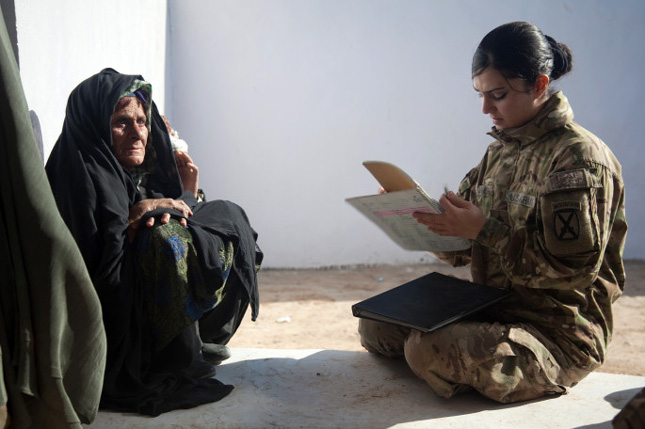-
The Hillary Doctrine: Sex and American Foreign Policy (Book Launch)
July 14, 2015 By Linnea Bennett
When Valerie Hudson evaluates the strength of a nation, whether food security, wealth, peacefulness, or quality of governance, she finds one important thread that underlies it all. “One of the most important factors in the determination of these things is in fact the situation, and security, and status of women,” said Hudson at the Wilson Center on June 24. [Video Below]
In a new book, The Hillary Doctrine: Sex and American Foreign Policy, Hudson and co-author Patricia Leidl systematically examine the evidence connecting the treatment of women with national security. They find that, yes, the empowerment of women is connected to national security.
“Compare those societies that respect women and those who don’t,” said Hudson, quoting former Deputy Administrator of USAID Donald Steinberg. “Who’s trafficking in weapons and drugs? Who’s harboring terrorists and starting pandemics? Whose problems require U.S. troops on the ground? There’s a one to one correspondence.”
Hudson and Leidl also plumb into recent U.S. efforts to incorporate gender into foreign policy, including but not limited to Clinton’s four years as Secretary of State.
A “Time-Limited” Opportunity
The term “Hillary Doctrine,” refers to a speech by then-First Lady Hillary Clinton at the 1995 UN World Conference on Women in Beijing. “Human rights are women’s rights and women’s rights are human rights,” she said. Fast forward 20 years, and Clinton’s time as Secretary of State was momentous for women’s issues. In her four years, Clinton demonstrated that “women and security go hand in hand,” Hudson said.
That’s not to say Clinton has not faced criticism. Some think she did not go far enough in pursuing a feminist agenda, declining to publicly denounce countries like Saudi Arabia for their treatment of women (other world leaders have seen repercussions from doing so, including recalled diplomats and cancelled contracts). Others argue that Clinton went too far in her agenda and has “blood on her hands” for encouraging Afghan women to raise their voices knowing they would face violent repercussions once the U.S. left, said Leidl.
These conflicting opinions come with the territory, said Hudson. “There are many moral quandaries, land mines, you name it, that result from the desire to pursue a feminist foreign policy.” Unintended negative consequences will result from either approach – soft or strong.
“We were driving the car and building the road at the same time”Part of the challenge with getting gender on the map at the national security level is the paucity of women leaders, thinkers, and practitioners in the space. Daniela Ligiero, vice president of women and girls strategy at the UN Foundation, said that when she was invited to work as a senior gender adviser in the State Department under Clinton, she felt she had “been invited to make history.”
“For those of us who work on gender issues and care about women and girls, we knew this was going to be a time-limited opportunity to create the most change possible for women and girls within our foreign policy,” Ligiero said. “The feeling, constantly, was that we were driving the car and building the road at the same time because there was so much we needed to do and change within that apparatus.”
Gender did become a major component in the first Quadrennial Diplomacy and Development Review – women and girls were mentioned 133 times in the report’s 242 pages – and women’s empowerment was “mainstreamed,” at least on a theoretical level, into the Department of State’s activities, said Hudson.
Implementation in the Field a Major Challenge
Implementing programs that follow those guidelines, however, has been a more difficult task, said Leidl. When interviewing aid workers, contractors, human rights advocates, and other field workers, Leidl said she found that elevating women and girls was often seen as a “pet rock” that slipped through the cracks when rubber met the road. “It was considered to be an expendable; considered to be something of an indulgence; something that was being done to please the higher-ups in Washington who didn’t actually know what they were doing.”
Part of this has to do with a lack of concrete benchmarks and program goals, said Leidl, like ensuring a certain number of women were a part of peace talk negotiations. Even though implementers were told to do “gender work,” they were not given specifics on how to go about it, which meant they often ignored it altogether.
“If we’d intervened, we probably would have been killed”The background of the workers on the ground was an issue as well. Many contractors in Afghanistan were former military personnel who lacked the knowledge and skills to navigate deep-seated, complex gender issues, said Leidl. And those locals that worked with the contractors were often men who came engrained with gender biases. Girls’ schools, for example, were often built more shoddily than boys’ and lacked crucial amenities like toilets which severely curtailed the number of girls – particularly teenagers – who would attend.
When in the field, “one is constantly faced with the conundrum of either adapting and therefore tacitly endorsing some really foul behavior,” Leidl said, “or upsetting the apple cart and jeopardizing the entire operation.” She recalled an experience in one small Afghan town where she and others were distributing grain. Men and boys of all ages actually stepped on women, some of them elderly, to get to the grain as if they didn’t exist. “If we had intervened, we probably would have been killed,” she said.
Likewise, in parts of Latin America, murder rates of women are increasing as much as 21 percent a year, despite a leveling off of homicide rates overall. Violence against women and girls, for no other reason than their sex, is so routine, you could call it a “gynocide,” Leidl said. “If you really want to instill fear into an entire community, you go after women.”
The Future of the Doctrine
Dislodging such casual disregard for women’s lives can’t be expected to be a straightforward or speedy process, said Hudson. “The alternative would have been what?” she said, turning to a quote from Anita McBride, former chief of staff to First Lady Laura Bush. “The tough work is to get out there and help.”
The tenets of the Hillary Doctrine are spreading outside the Department of State too, said Rosa Brooks, a law professor at Georgetown University and former counselor to Under Secretary of Defense for Policy Michelle Flournoy and special coordinator for rule of law and humanitarian policy at the Pentagon. She said many young military officers who returned from the wars in Iraq and Afghanistan noticed the vital role women played in the communities they were stationed. “These guys had seen first-hand how important it was to work with women,” she said. She recalled a young Army National Guard major who “[came] back deeply believing that if you don’t get women into key leadership roles, nothing good and nothing enduring is going to happen.”
As new generations move up the ranks, the patriarchal lens that has dominated military and security strategy may begin to fade, Brooks said. “At the end of the day, this is going to change partly because of change with the architecture and it’s going to change when suddenly half the senior leaders at the State Department and the Defense Department are women,” she said.
From diplomats and contract workers to citizens on the ground, minds must be changed at every level, said Kathleen Kuehnast, senior adviser for gender and peacebuilding at the United States Institute for Peace. “That kind of change really happens in the nuance; it’s in the daily relationships; it’s in the conversations.”
“I think that the legacy of the Hillary Doctrine will be judged by whether the phrase ‘Hillary Doctrine’ will disappear,” said Hudson. “When it becomes the unremarkable way to look at things…that’s when we’ll know that the Hillary Doctrine succeeded.”
Event Resources:
- Valerie Hudson and Patricia Leidl’s Presentation
- Friday Podcast With Valerie Hudson and Patricia Leidl
- Photo Gallery
- Video
Sources: Financial Times, The Guardian.
Photo Credit: A U.S. Army Female Engagement Team in Kandahar Province, Afghanistan, courtesy of Kristina Truluck/U.S. Army.
 A Publication of the Stimson Center.
A Publication of the Stimson Center.






